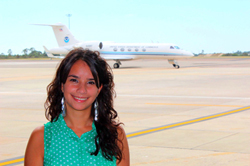Atmospheric Science Student Turns Childhood Experience into Exciting Future
.jpg) |
|
UAlbany atmospheric science student Rosimar Rios-Berrios learned to process storm data aboard the G-IV aircraft on a flying research mission around Hurricane Sandy. |
ALBANY, N.Y. (Nov. 21, 2012) — Hurricane Sandy’s devastation has left many communities reeling, a shock that UAlbany atmospheric science doctoral student Rosimar Rios-Berrios understands first-hand. In 1998, at the tender age of nine, the Puerto Rican native wrote in her journal, “I am so scared. A tropical cyclone is approaching our island. It is a Category 3 hurricane with maximum sustained wind speed of 115 miles per hour.” The storm hit her hometown of Barranquitas, Puerto Rico, leaving her family without electricity or hot water for more than a month. While her family’s house was spared, many of her neighbors lost their homes.
 |
|
Rosimar Rios-Berrios sees her future in communicating the science of hurricanes to the general public so that people can protect their families and property. |
Despite this traumatic experience, Rios-Berrios grew to love weather and decided to pursue an education in atmospheric science. Recently she leveraged opportunities from another hurricane to advance her career path.
Recently as Hurricane Sandy barreled down the U.S. coast, Rios-Berrios was attending a science workshop in Tampa, Fla, She had heard the National Oceanic and Atmospheric Administration’s (NOAA) Aircraft Operations Center (AOC), also in Tampa, was flying research missions around the hurricane. She visited the Center to discover a seat opened on a surveillance mission and quickly seized the opportunity.
“I told them I was an atmospheric science student at the University at Albany working with Professor Ryan Torn. That’s when they knew I was serious about the mission,” she said. “UAlbany has a very strong atmospheric science program and everyone in the research field knows about it so I knew it would be a boost to my career.”
Torn, her adviser in the Department of Atmospheric and Environmental Sciences, works with the Hurricane Forecasting Improvement Project. As it turned out, he was also flying into Sandy on a separate aircraft the same day. Working with Torn strengthened her connection to NOAA, and helped her gain access to the flight. She boarded the Gulfstream-IV (G-IV) plane tasked with measuring the storm’s development and recording data through instruments dropped around the storm (dropsondes).
According to Rios-Berrios, once the dropsonde hits the water, you get a vertical profile of the atmosphere. The scientists then collect the data, check it for quality control, and communicate it to weather forecasters at the National Hurricane Center. The flying laboratory provides data that improves the accuracy of numerical models, thus improving weather forecasts.
“It is amazing that this system was forecast over a week before it hit. This shows you how much forecasting techniques have improved,” she said.
Watching the storm from above the clouds, Rios-Berrios hoped it would not intensify as the data predicted, however even from 45,000 feet up, she could see the whitecaps of fierce ocean waves, a harbinger of the approaching storm surge.
The UAlbany student points out the critical link between the science conducted and communicating that science to the general public so they can prepare. That communication is essential to creating public awareness, not fear or hysteria, about an approaching storm.
She sees her long-term career goal as one in which she can translate the science of weather for the public to help people protect their lives and property. This would include research, teaching and mentoring.
“If I can do it, other students can too,” said Rios-Berrios. “Hopefully, my experience will inspire others who are dreaming about working in this exciting field.”
![]() For more news, subscribe to UAlbany's RSS headline feeds
For more news, subscribe to UAlbany's RSS headline feeds
A comprehensive public research university, the University at Albany-SUNY offers more than 120 undergraduate majors and minors and 125 master's, doctoral and graduate certificate programs. UAlbany is a leader among all New York State colleges and universities in such diverse fields as atmospheric and environmental sciences, business, education, public health,health sciences, criminal justice, emergency preparedness, engineering and applied sciences, informatics, public administration, social welfare and sociology, taught by an extensive roster of faculty experts. It also offers expanded academic and research opportunities for students through an affiliation with Albany Law School. With a curriculum enhanced by 600 study-abroad opportunities, UAlbany launches great careers.


